Water Filters

Any water that we take from various sources, carries a number of impurities. It can be mechanical sediment, various plaque and rust, residual impurities from the passage of water through the pipes and many other substances that must be removed from drinking water, because it is absolutely impossible to drink and use in household utensils.
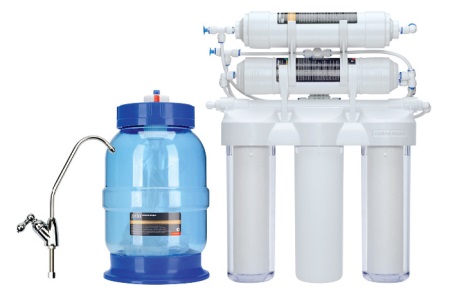
A coarse filter will help significantly reduce the amount of harmful substances and particles. And the use of fine filters helps to prevent residual dirt, various metal compounds and bacteria from getting into our water. In order to choose the right filter, you need to have your water analyzed for chemistry and bacteria.
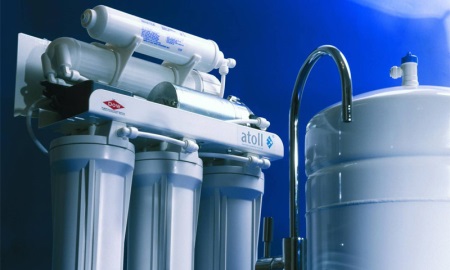
Types of filters, their pros and cons
All filters can be divided into degrees of purification:
- coarse cleaning;
- medium purification;
- Fine filtration.
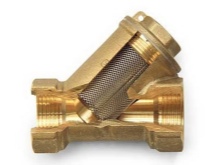
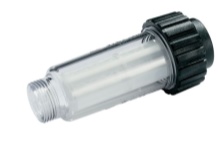
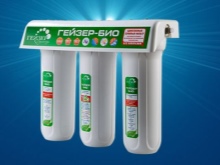
Types of coarse filters
You can install a coarse filter on both the cold and hot water supply, thereby significantly improving water quality. Since the water supply in our cities is by no means ideal, and in the water "from the tap" you can find a lot of garbage, which in different ways gets into what we drink.
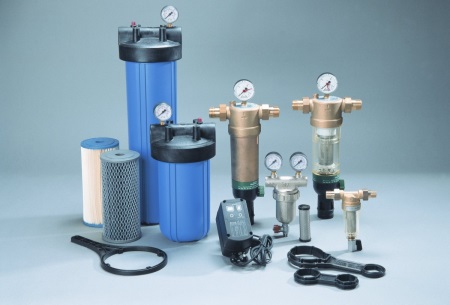
Mesh filters
These aquafilters have pretty much the same construction. If you look inside the housing, you can see a mesh made of metal (or another debris-proof filtering attribute of this type of design, such as disks). There is always an outlet in the design where all the dirt and debris sifted out by the filter element accumulates. If the strainer becomes clogged, no water is supplied and the outlet is cleaned and flushed out. Perform preventive cleaning of the dirt trap at least four times a year.
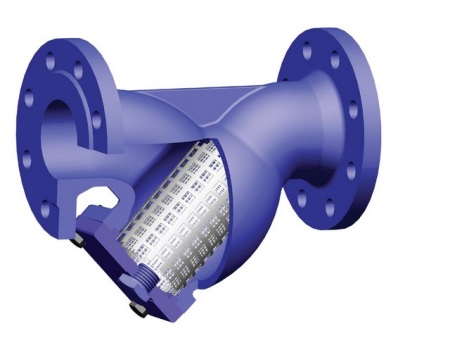
The filtering attribute of the strainer strainers is a stainless steel mesh. Its mesh size is approximately 50 to 400 microns. The aquafilter should be installed in such a way that the revision opening is located at the bottom. Attachment of such a filter to the pipeline should be checked for leaks and to prevent leaks.

The undoubted advantages of all strainers are:
- long lifetime;
- small size;
- ease of operation;
- simplicity in installation;
- low price.
Mesh aquafilters can be subdivided into oblique and straight, depending on the direction of the sump.
- Aquafilters with an oblique direction of the strainer are used in pipes, which are laid at a very small distance from the floor and at vertical level.
- Aquafilters with a straight strainer direction are slightly larger in size. Due to this they make the water much better. This type of filter requires more space under the pipe for installation. In these aquafilters, the strainer is closed with a flange cover or threaded plug.
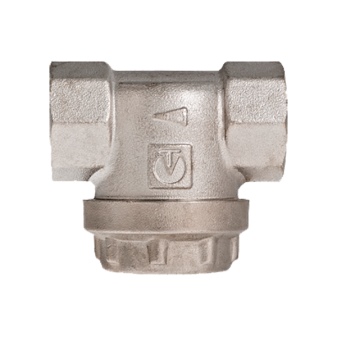

Mesh aquafilters can also be divided into socket and flanged, depending on the tapping.
Flanged aquafilters are required on pipelines that are larger than 2 inches in diameter. This may be main pipelines or tie-ins to consumers. Flanges can be bolted or stud mounted. Thanks to this fastening, they are easily removable, which allows you not to dismantle the rest of the system.
These filters are used according to the project documentation. In other cases, if the diameter of the pipeline is less than two inches, put muff filters - on the thread.
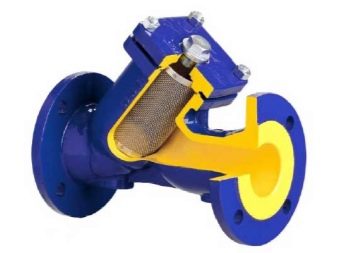

Strainer filters can also be subdivided according to the method of purification of the sump. They can be non-purging and self-purging.
Another name for non-purging aquafilters is "strainers". These include oblique strainers and a certain number of straight strainers, which have a cover in their composition. To clean the strainer, the unit must be disassembled and flushed.
Self-cleaning aquafilters are straight filters that have an automatic flushing system. These filters are equipped with a discharge valve, which drains the sediment into the sewage system. It is also possible to order an automatic flushing block - a timer. It is usually programmed to open the valve, which is installed on the drainage hole.
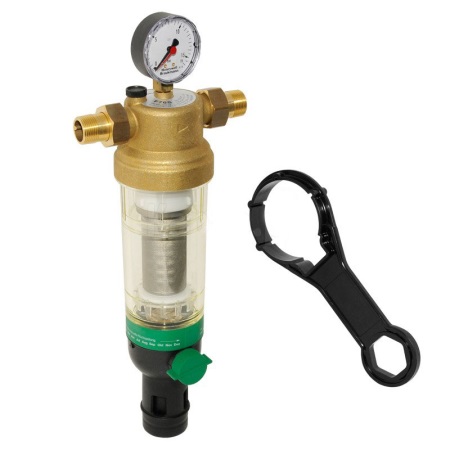
Aquafilters
Cartridge aquafilters are equipped with a relatively large bulb with clear or opaque walls. Such filters are attached to the wall surface. The bulb holds a replaceable cartridge. The material of which the cartridge is made can be different: polyester, polypropylene filament, compressed fiber. They have different filtering capacity.

For coarse filtration, cartridges from 200 μm are chosen. When the elements in the aquafilter become clogged, the cartridge is replaced with a new one together with the mesh elements, which can be installed - and this is very actively used - in front of the bulbs to make the filtration more reliable. It is not allowed to rinse and reuse such cartridges.

To the undeniable advantages of this filter can be attributed the following aspects:
- purification by such aquafilters has a high degree;
- Are relatively inexpensive.

High-speed pressure aquafilters
High-speed pressure aquafilters are special filters for water with a high percentage of impurities. These are containers made of corrosion-resistant materials that are filled with a filtering compound. This composition makes water clean of contaminants as small as 30 microns.

Pros:
- Compared to the aquafilters described above, this type of filter has a high quality of water purification from impurities
Disadvantages include:
- dependence on ambient temperature: can only be used in a warm room;
- large dimensions of the filter device;
- complicated installation;
- high price.
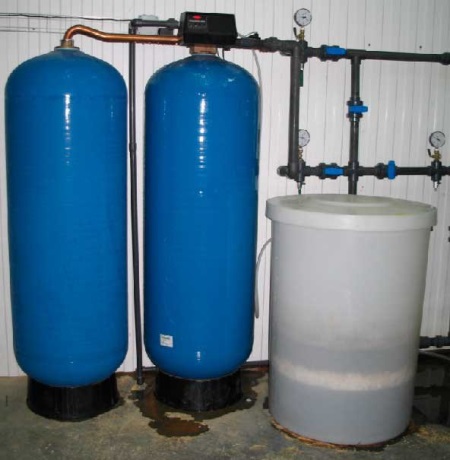
Types of aquafilters medium purification
The purpose of such filters - purification of water to the level of drinking water. They come in 2 and 3-stage, which are also subdivided into single-barrel and multi-barrel. Install these aquafilters should be under a sink or on a table, it all depends on the variety of filtration apparatus.
- 2-stage aquafilters are based on the fact that the 1st stage is designed for mechanical cleaning, and the 2nd - for cleaning with activated carbon.
- Three-stage aquafilters are supplemented by a 3rd stage: cleaning with pressed activated carbon or ion-exchange resin, which are enriched with various additives (silver, ion-exchange agent, sodium hexametaphosphate, etc.).
These aquafilters in this category are equipped with a replaceable element: the cartridge.

The advantages of such filters are:
- purification from mechanical suspended solids, chlorine and organic chlorine compounds;
- Long cartridge life;
- elementary service.
Of the disadvantages it should be noted:
- high cost;
- partially cleans from bacteria and viruses, chlorides, nitrates, fluorides;
- partially cleans from pesticides, iron, manganese, heavy metals, oil-containing products.
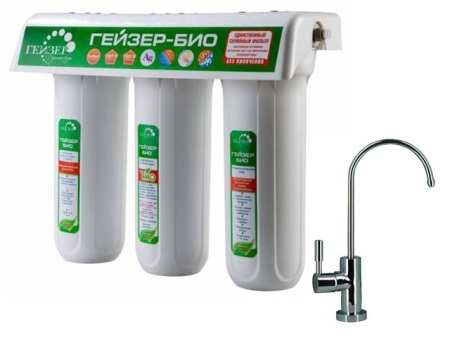
Types of water filters for fine purification
To get the purest water after the filters of coarse water purification it is recommended to install fine filters.
Fine water filters can be divided into two types according to their functionality:
- single-function - aquafilters capable of purifying water from chlorine, trace elements, salts and metals;
- Multifunctional - aqua filters that perform several actions simultaneously.
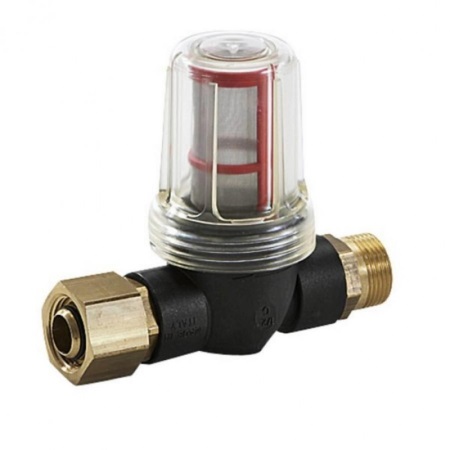
For proper operation of such multifunctional aquafilters, it is necessary to replace the cartridges in time. How and at what intervals to replace can be found in the passport of the device.
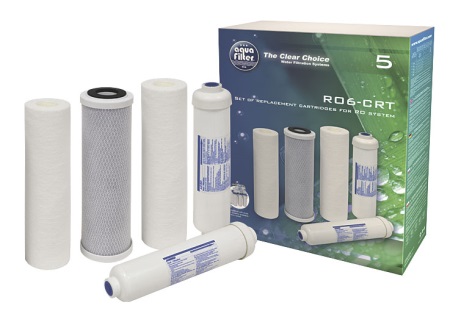
There are several varieties of water filters for fine cleaning:
- with reverse osmosis;
- sorption;
- fabric filters;
- mineral;
- ion-exchange.

Reverse osmosis.
Efficient water filtration units equipped with several stages of purification.
Osmosis is the transfer of water from one saline solution to another more saturated solution. Reverse osmosis - the transition of water from a more saturated solution to a less saturated one. That is, reverse osmosis decreases the saturation of salts in the liquid.

During reverse osmosis, water flows through a semi-impermeable membrane. The membrane prevents it from taking organic chlorine compounds and herbicides with it because only molecules smaller than the membrane can seep through its structure, that is, water molecules, oxygen and molecules with even smaller sizes.

This system has several stages of purification.
- The first stage is very important. This is where the water is prepared in order for it to reach the membrane. This stage uses 3 purification elements during reverse osmosis. The 1st element polypropylene fiber or propylene filament cartridge performs the mechanical cleaning. Here the water is cleaned from particles larger than five microns, such as rust, sand, scale, etc.
- The second aquafilter has in its composition a cartridge with activated carbon in granules, which allows water to be purified from organochlorine compounds, herbicides, pesticides, various flavors and bad smells.
- The third aquafilter has in its composition pressed carbon. It removes organic compounds, volatile organic substances (tetrachloride, benzene, carbon) and fine particles of carbon dust.
After the initial purification, the liquid is sent to the membrane. At the output we get high-quality water, suitable for drinking.
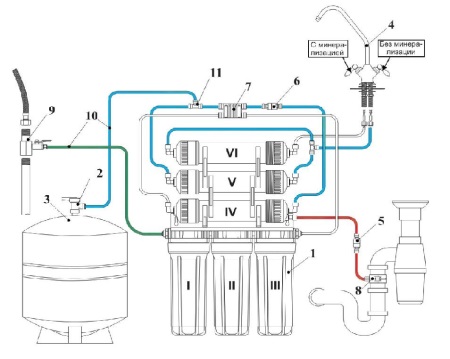
The disadvantages of this system are:
- salts and minerals that are good for us are washed out;
- for improved purification there must be pressure in the plumbing, which leads to additional costs, that is, a pump is needed;
- connection to electricity;
- low speed of purification.
Undoubted advantages:
- Can remove 99% of the dirt from the water;
- good price for excellent quality water.
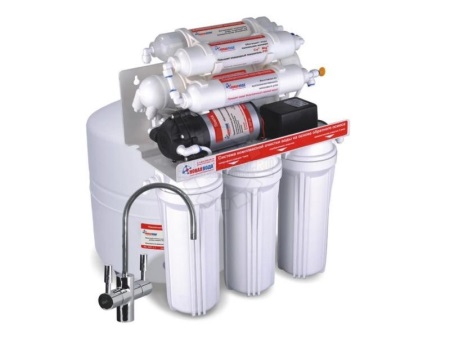
In reverse osmosis filters, it is also necessary to periodically change the cartridges. The manufacturer, as a rule, specifies the information on how often it should be done in the filter manual. In the following video, you can see how to properly replace the cartridge in an aquafilter.
Sorption
Sorption is the absorption of another substance by the absorbent. These devices are also called charcoal. They work on the principle of adsorption - retention of molecules with the help of a solid body.
Aquafilters look like a tank of plastic in which there is a sorbent (activated carbon). Such filters purify water from chloride compounds, gases and organic substances.
Ion-exchange substances are used to improve purification with a charcoal filter. This allows you to remove heavy metals, pesticides, herbicides, asbestos and petroleum products.
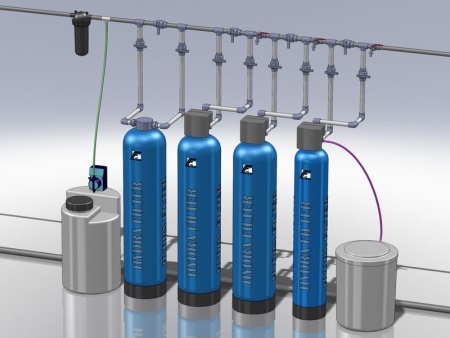
From the pluses it is possible to note the big productivity: 2 liters per minute, and also considerable resource: almost 8 thousand liters. And the price, by the way, is quite small.
Of the disadvantages of this system can be highlighted the accumulation of harmful substances, which, if you do not follow the filter, can be washed out, and in toxic doses.
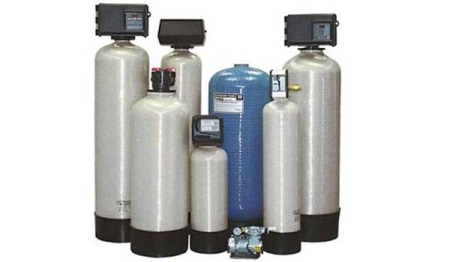
Cloth
The fabric aquafilter is characterized by a simple design. It looks like a cylinder wrapped with a rope or harness. This filter cleans the water from metal oxides, some chemicals and low-soluble salts.
This aqua filter is consumed when the rope or harness changes its color. In such cases, it is necessary to replace the filter material or boil it to make the cloth white again.
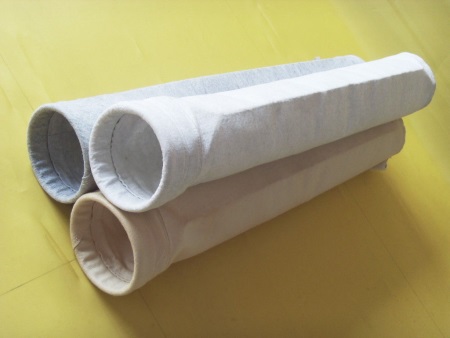
The pluses of the fabric aquafilter are that they are inexpensive and easy to use. Cons: not all harmful substances can detain.
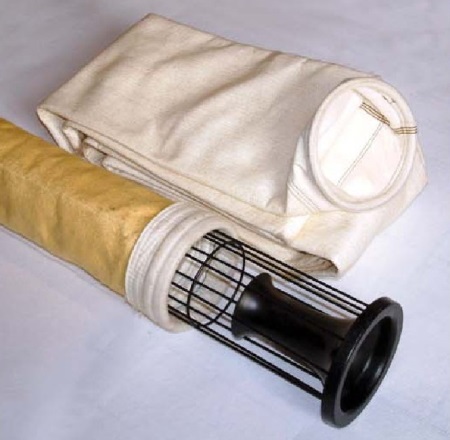
Mineral
A mineral aquafilter is a cylinder-mesh, inside which there is a crumb of minerals. Its purpose is to purify water from salts and chemically aggressive additives. If a deposit has formed on the cylinder, then such a filter has exhausted its resource and should be discarded, as it is not recoverable. There are also adhesive filters based on minerals.
Such filters help purify water to the highest quality, taking in even compounds that have been dissolved in the water. The filter should be replaced when the color of the cylinder has changed.
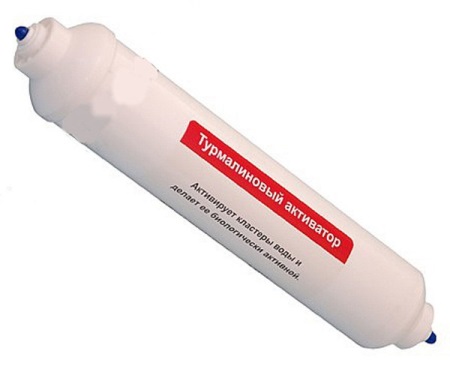
Such filters help purify water in the best possible way, taking in even compounds that have been dissolved in the water. The filter should be replaced when the color of the cylinder has changed.
Cons: If the filter is not looked after, pathogenic bacteria will begin to breed inside the filter, which can cause poisoning.
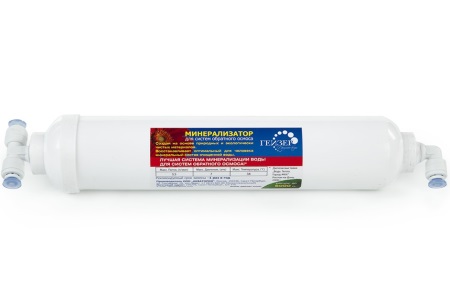
Ion-exchange
The cleaning method is to replace the mineral hardness salts with other chemicals that would make the water soft. The purification takes place in filters with resin ions. Ion-exchange resin looks like polymer pellets. These resins replace metal ions with sodium and some with hydrogen. The reaction gives a mildly acidic environment that is not harmful to human health, and is even beneficial.
The design looks like a cylinder with flanges through which a special gas enters and exits. In the middle of the cylinder there is a block with a filter, which includes ion-exchange materials in the form of fiber.
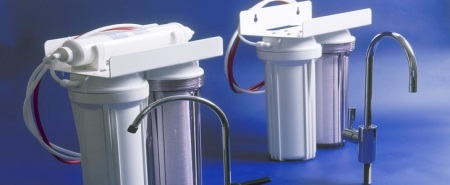
Advantages include:
- high performance;
- easy replacement of cartridges and long service life;
- preservation of useful substances after purification;
- removal of many bacteria, heavy metals, viruses and toxic substances;
- many installation options.
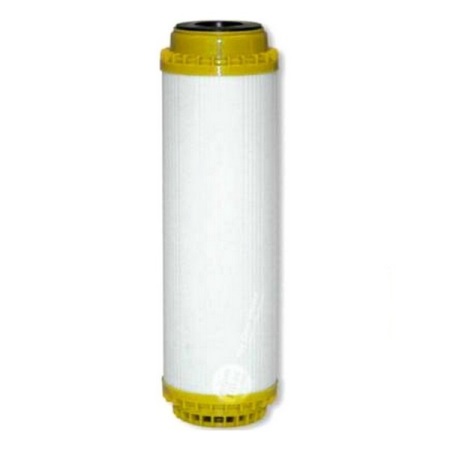
Magnetic filters for water
Separately allocate aquafilters magnetic purification. They are found in all degrees of purification.
Magnetic filter - a unit that has several magnets in its composition. The liquid, passing in a perpendicular axis of force lines, rejects debris, and the water is rebuilt. This effect rids pipes and various containers of salts and scale.

The advantage is a high degree of cleaning and no need to use different kinds of solutions.
The disadvantage is the high price.
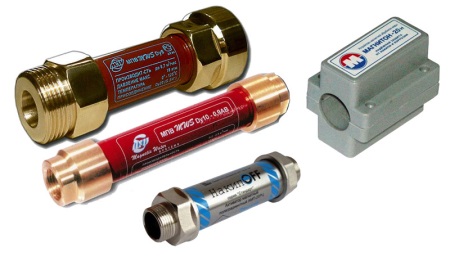
There are several types of magnetic filters:
- Magnet-flange;
- magnetic coupling;
- magnetic water softener.
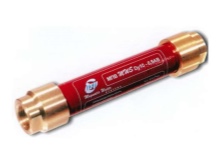
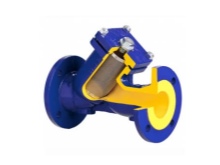
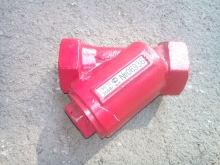
Magnetic flange filter or magnetic-mechanical flange filter
Effectively protects against iron salts. Also with its help water is cleaned from sand, silty deposits.
The filter material is cast iron. The device has a steel mesh and a plug.
Cleaning of water is done in a process that consists of two stages:
- Retention of suspended particles by the mesh;
- Cleaning of the liquid with the help of a magnetic field.
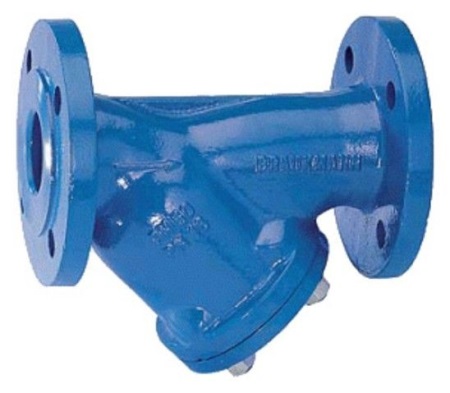
Advantages include the following:
- effectiveness against iron;
- low price.
Disadvantages:
- does not clean other types of impurities and salts
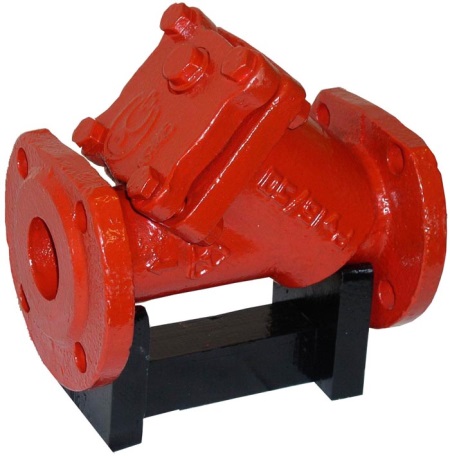
Use this aquafilter when purifying hot and cold water.
Magnetic coupling filter
Magnetic socket filter is similar in its work to the magnet-flange filter. Such an aquafilter is needed in places where the iron content in the water is very high.
The disadvantages include low durability compared to the magnetic-flange aquafilter.
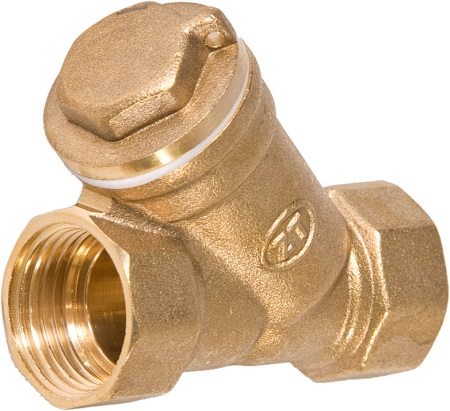
Magnetic water softener
This type of magnetic filters is a special case in the use of magnets in water purification. It is often used in water treatment systems. A magnetic softener flattens hardness salts to safe compounds.
Pros:
- Does not require constant maintenance;
- does not require the use of chemicals;
- does not require electricity.
Cons:
- The amount of salts in the liquid does not change;
- high price.
Water filters can also be divided by modification. One modification of the aquafilter is the jug type.
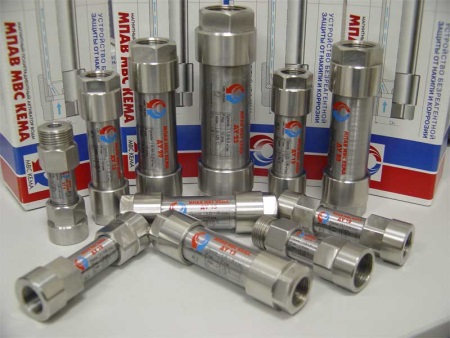
Magnetic water softener jug type
The principle of operation of this type of aquafilter is very simple: water is poured from the top of the jug, and through the cartridge it passes into the storage tank.
Pros:
- No need to connect to the tap with water;
- no need to constantly monitor the process, because the water will not overflow from the jug;
- Versatility of interchangeable cartridges: you can put any cartridge on any water problem from the manufacturer whose jug you use;
- ease of use.
Disadvantages:
- No more than 1.5-2.5 liters of water can be filtered at a time;
- Low purification rate: 0.5 liters per minute and low life span: 150-400 liters;
- low filtering capacity.
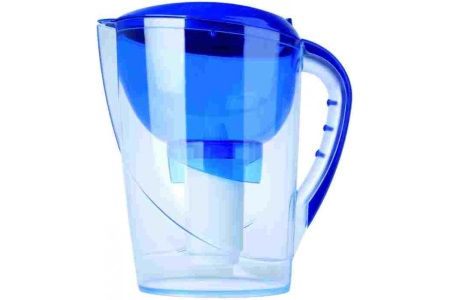
Faucet nozzle
The device of this type of filters looks like a small cylinder that is put on the faucet. Its ability is to clean the liquid from chlorine and iron. Also, this filter is able to make the water softer.
Faucet nozzles come in removable and stationary. Removable nozzles are put on an adapter so that it can be removed if necessary, while stationary nozzles are attached to the faucet. They have a switch for purified and unclean water, which is very convenient.
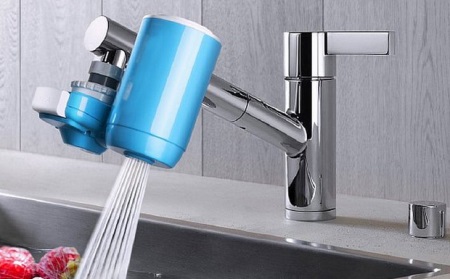
When using hot water, the aquafilter must be removed, which is not very convenient. If this happens suddenly, you need to rinse the aquafilter with five liters of water.
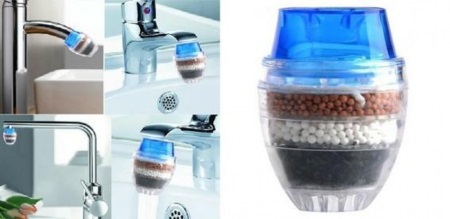
Pros:
- Very small size, convenient to take with you;
- Some models have a water direction switch (either through the filter or past the filter);
- affordable price.
Cons:
- small capacity: up to 0.5 liters every minute;
- low resource nozzle: 2-3 months;
- if you do not use different switches, you will have to constantly take off and put on the filter.
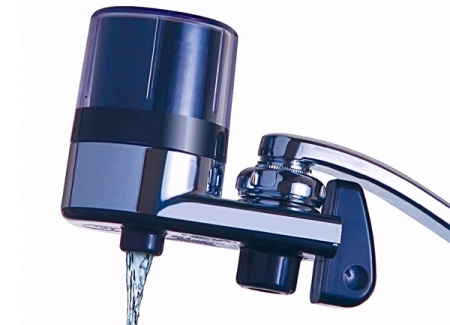
Desktop filters ("on the sink")
These aquafilters are mostly flow-through type. It looks like a cylinder with a faucet. They are connected by a hose to the faucet.
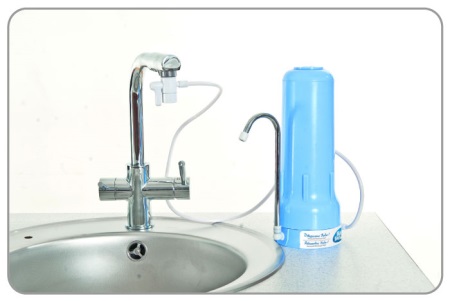
With the help of this filter water becomes softer, the content of heavy metals and iron is corrected.
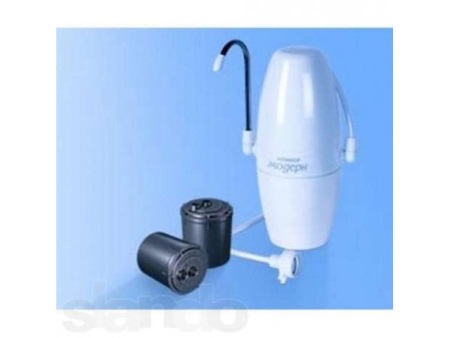
The pluses include the following:
- high performance: 2 liters every minute;
- good resource: 3000-4000 liters;
- the possibility to save on the place of installation by purchasing a model with wall mounts;
- high degree of purification;
- ease of operation and mounting.
The disadvantages can include:
- The location of the aquafilter directly next to the faucet;
- relatively large dimensions.

Stationary filters ("under the sink").
These devices look like several cylindrical containers with a variety of filtering substances. The connection is made directly to the pipe, and fastening - under the sink. At the sink next to the main faucet, an additional faucet is installed, through which a special pipe flows improved water.
Such filters are able to remove unpleasant odors, chlorine and impurities from the water.
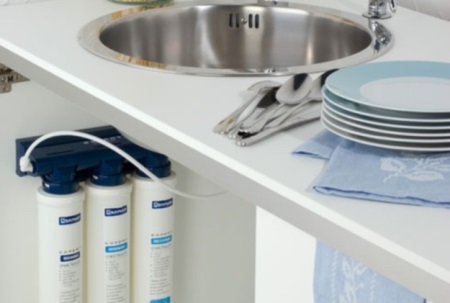
The advantages of this purification system include the following:
- saving installation space, as you do not have to obstruct the familiar surroundings with unnecessary devices;
- high degree of purification;
- huge resource: up to 10,000 liters;
- high degree of productivity: 1.5-5 liters per minute.
The disadvantages can include:
- The high cost of the cleaning apparatus.
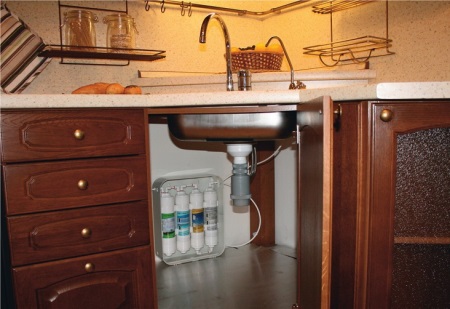
What to consider when choosing?
In order to choose the right water filter, you need to gather the following information:
- where the filter will be used;
- what degree of purification is necessary;
- What kind of filter is preferable;
- Know the quality of the water used (for this you need to take water tests);
- price range;
- preferred companies.
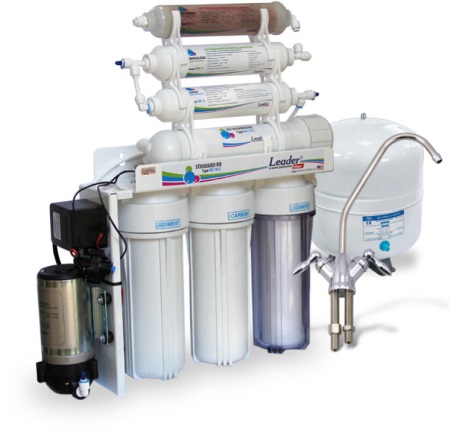
The most popular devices include the following devices: Aquafor, Barrier, Geyser, Rodnik, Brita. These brands can be easily found on the Internet or search in stores that specialize in cleaning units. Not always shopkeepers clearly describe all the nuances of the product purchased by the buyer.
Using a minimum knowledge of a certain type of filter, you can easily buy the best filter you have dreamed of.
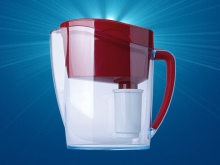

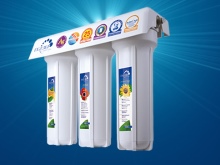
For a private house - from a well
Suburban houses are growing like mushrooms in the forest, so the number of houses outside the area of water supply is also increasing. In this regard, people begin to drill wells and think about purification filtering units. After all, no one wants to part with a new water heater or kettle because of poor-quality water, and the health of some people will not allow to use such untreated drinking water.
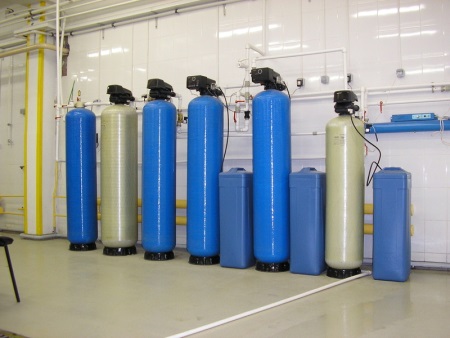
The task of filters for such use - to clean water from impurities such as sand, clay, biochemistry, rust.
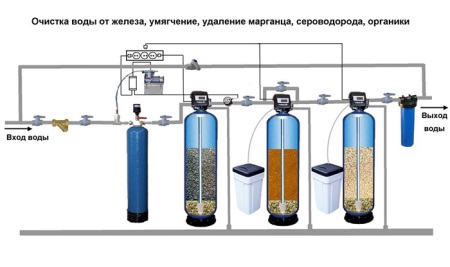
For summer homes.
Most likely, after receiving water tests from the dacha site, the biochemistry will say that the liquid contains such substances as iron and hydrogen sulfide. So, there is a need to use filters with multi-stage purification. Mechanical purification will rid the water of sand and clay, and a deeper purification will help reduce the hardness and give the water a pleasant taste.
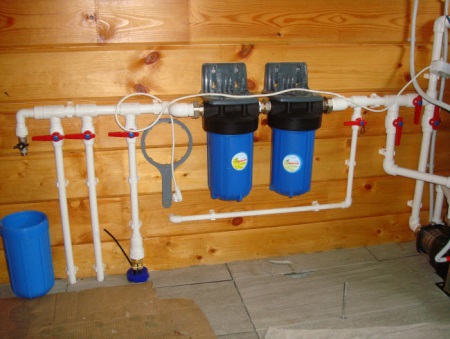
If you are connected to the water supply at the site, it is necessary for the filter to contain elements that will help eliminate the chlorine elements and odor.
For apartments
Water purification in apartments is very often forgotten, because they do not give it the importance it deserves. But water is used in large quantities and is not always healthy. The quality of water in our water pipes is practically not improving. Therefore, it is necessary to monitor what we drink.
Filters that are installed in apartments come in different types, each of which is unique in its own way.
- Built-in filters.
- Filters installed under the sink (stationary).
- Desktop filters.

Which filter is better to choose?
Remember that the filter material is not durable: sooner or later the membranes will clog, and the sorbent will fill with harmful substances. Therefore, it is necessary to replace the replacement material in time.
Some manufacturers produce calendars along with the products, such as "Aquafor", or indicators - firm "Brita" - that remind users of the need for replacement. But it also happens that after some time of using an aquafilter filtration rate drops, which means that the filtering part of the device has exhausted its life and it is time to change it, despite the fact that the "reminders" to do so is too early.
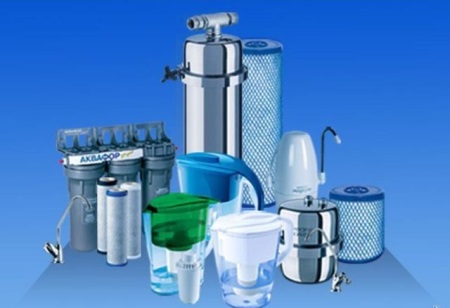
According to the efficiency of filters, the highest place is occupied by multistage filters.
- The cheapest option from $7 to $20 at the nozzle on the faucet of such manufacturers as "Geyser", "Aquafor", "Barrier" and "Rodnik". You can read more about this type of filter in the article above.
- Bucket filters are a little more expensive: up to $40. They are more convenient than nozzles, but less effective. These aquafilters are made by the same manufacturers as the nozzles, the only thing added is the "Brita" brand. The jug filters of this manufacturer reach the $70 mark, but for that kind of money you get a high life span of the cassettes. Additionally, the models of this brand have an indicator, which is very convenient.
- "COOLMART" - manufacturer of storage aquafilters with a volume of 3 to 6 liters. The filtration rate in this aquafilter is 1-3 liters per hour. But, in addition, the liquid in the aquafilter for best results should contact with the antibacterial layer for quite a long time: from 6 to 22 hours. The price of such filters from $100 to $180.
- Aquafilters "at the sink" from "Geyser", "Aquafor" and "Rodnik" have a price tag of up to $150.
- The price of stationary filters goes beyond $150. They have the ability to connect the filter even to hot water, but not all models. If you take such a modification of the filter in the cottage well, then get ready to pay "a penny", because necessarily to such a filter need an aquafilter prefilter and a module of disinfection and softening ("Atoll", "Ecowater"). The cost of such a system will come out about $1000.
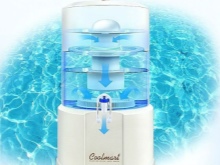
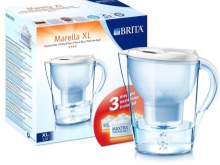
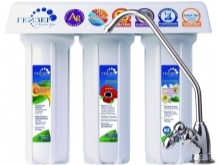
In the following video you can see why it is so important to install a filter, how to choose it correctly, what to pay attention to first and what kind of filter is better to buy for certain purposes.
Choosing a filter is always an important detail in a person's life, because everything depends on water quality, even life expectancy. So be sure to analyze the water you use. Then read carefully the section "what to consider when choosing" and buy the filter that is suitable for you. Because clean water is always nice!




